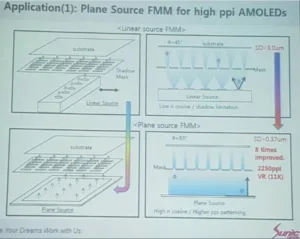The Korean display manufacturing tool maker, Sunic System announced a new manufacturing method that allows to produce high resolution AMOLED displays using fine metal masks (FMM). While metal masks have been used in AMOLED manufacturing already, the trick to increasing the achievable pixel density lies in the newly designed flat evaporation source.
At the recent IMID 2016 in South Korea they showed a poster with an explanation on how their system works. While current evaporation sources rely on smaller area sources, Sunic deposits the OLED material on a flat sheet and evaporates from there. This results in a much smaller deposition cone as the material passes through the FMM.
Source: EE Times Europe
There are several reports from news sources (EE Times Europe) that connect the Sunic System announcement to the recent Samsung announcement at SID 2016, where Samsung talked about a 806 ppi (3840 x 2160 pixels with a 5″ diagonal) AMOLED panel that is aiming at the VR market.
A planar source like the one developed by Sunic System could also open a way for the cost effective manufacturing method for larger size display panels including TV sizes.
Analyst Comment
As it seems, this all goes back to 2015 when the Android Authority and others reported on a plan from Samsung to develop an 11k AMOLED display with a pixel density of 2250 ppi. This was seen as a long term goal for Samsung with having a display ready for the 2018 Winter Olympic games. They were cooperating with several other companies to achieve this goal and it was assumed that the 806 ppi display was part of this project.
The recent presentation from Sunic System at IMID 2016 refers to the exact specification Sasmsung put out for their high resolution AMOLED display last year. It is not possible to say if this is the result of Sunic System being part of the Samsung team or if they read about the Samsung project and are just copying the specification to appear part of the team. Nevertheless, they use the exact specification and suggest as shown above that they are capable of achieving this goal already. (NH)

